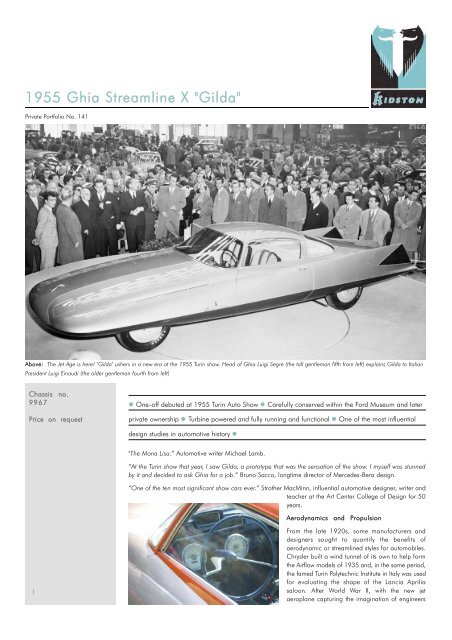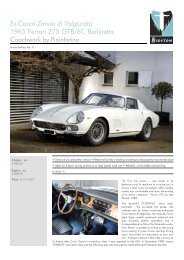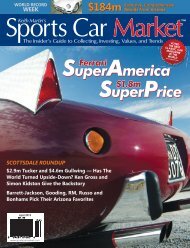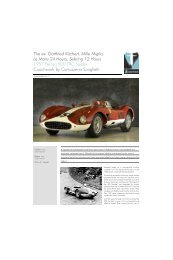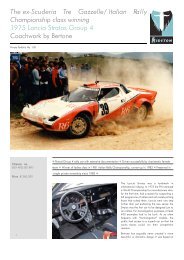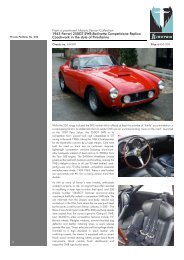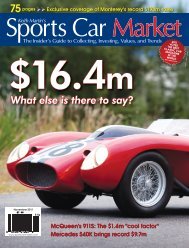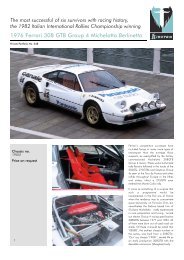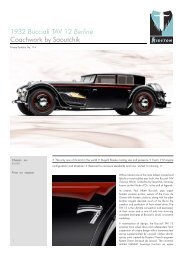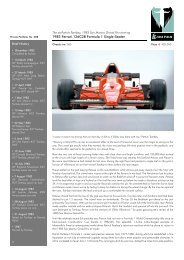1955 Ghia Streamline X "Gilda" - Kidston
1955 Ghia Streamline X "Gilda" - Kidston
1955 Ghia Streamline X "Gilda" - Kidston
Create successful ePaper yourself
Turn your PDF publications into a flip-book with our unique Google optimized e-Paper software.
<strong>1955</strong> <strong>Ghia</strong> <strong>Streamline</strong> X "Gilda"<br />
Private Portfolio No. 141<br />
Above: The Jet Age is here! ‘Gilda’ ushers in a new era at the <strong>1955</strong> Turin show. Head of <strong>Ghia</strong> Luigi Segre (the tall gentleman fifth from left) explains Gilda to Italian<br />
President Luigi Einaudi (the older gentleman fourth from left)<br />
Chassis no.<br />
9967<br />
Price on request<br />
One-off debuted at <strong>1955</strong> Turin Auto Show Carefully conserved within the Ford Museum and later<br />
private ownership Turbine powered and fully running and functional One of the most influential<br />
design studies in automotive history <br />
"The Mona Lisa.” Automotive writer Michael Lamb.<br />
“At the Turin show that year, I saw Gilda, a prototype that was the sensation of the show. I myself was stunned<br />
by it and decided to ask <strong>Ghia</strong> for a job.” Bruno Sacco, longtime director of Mercedes-Benz design.<br />
“One of the ten most significant show cars ever.” Strother MacMinn, influential automotive designer, writer and<br />
teacher at the Art Center College of Design for 50<br />
years.<br />
Aerodynamics and Propulsion<br />
1<br />
From the late 1920s, some manufacturers and<br />
designers sought to quantify the benefits of<br />
aerodynamic or streamlined styles for automobiles.<br />
Chrysler built a wind tunnel of its own to help form<br />
the Airflow models of 1935 and, in the same period,<br />
the famed Turin Polytechnic Institute in Italy was used<br />
for evaluating the shape of the Lancia Aprilia<br />
saloon. After World War II, with the new jet<br />
aeroplane capturing the imagination of engineers<br />
1
Private Portfolio No. 141<br />
<strong>1955</strong> <strong>Ghia</strong> <strong>Streamline</strong> X "Gilda"<br />
and the public alike, the drive to bring turbine propulsion to the road gathered force, with Rover, Fiat and<br />
Chrysler building prototype turbine cars in the early 1950s. It was only natural that the two streams of<br />
development, aerodynamics and turbine propulsion, would come together.<br />
Rita Hayworth and Gilda<br />
During the European marketing campaign for the 1946 film noir classic Gilda, actress Rita Hayworth was given<br />
the nickname ‘La Vedette Atomique’ or ‘the atomic starlet’ for her sleek lines and dangerous appeal. It may also<br />
have prompted an Italian design firm to name its equally sleek aerodynamic study for a jet-powered car after a<br />
character in an American movie. Certainly the glamour of Hayworth in one of her most memorable film roles<br />
suits the low, smooth and incredibly dramatic automobile. Its design contains elements which turned out to be<br />
a preview of what became Chrysler’s “Forward Look”.<br />
Jet Aircraft Design<br />
The styling of the Gilda <strong>Streamline</strong> X is the work of the<br />
legendary Giovanni Savonuzzi. A classic example of ‘jet<br />
a i r c r a f t’ design, it is a smooth, wing-like shape with<br />
practically every surface in curved or angled motion, an<br />
expression of speed when literally standing still. The<br />
<strong>Streamline</strong> X was commissioned by Chrysler design chief,<br />
Virgil Exner, who wished to explore solutions for cross wind<br />
resistance and rear-end grip as well as turbine power.<br />
E x n e r’s concern for stability was very real with hemi<br />
Chryslers pushing speeds toward 150+ mph. With the<br />
‘Forward Look’ Exner wrested styling leadership away from<br />
General Motors’ Harley Earl and put Chrysler at the helm.<br />
Details – The body and interior<br />
2<br />
The Gilda <strong>Streamline</strong> X gives the impression of almost a<br />
pure wedge in three dimensions, moving from the leading<br />
edge of the front end around the sides, ending at the sharp<br />
tips of the rear fins in an unbroken line. The body tapers<br />
from front to rear and the greenhouse slopes in all directions
Private Portfolio No. 141<br />
<strong>1955</strong> <strong>Ghia</strong> <strong>Streamline</strong> X "Gilda"<br />
down to the beltline. It is very well constructed, with a sturdy aluminum body atop a square tube chassis, a<br />
separate aluminum pan for the passenger compartment and a full belly pan for aerodynamic efficiency.<br />
Inside, it is both stark and stylish. The wool-covered seats have short armrests which also serve as side bolsters<br />
to hold you in place during cornering, while the dashboard’s two main instruments float underneath a binnacle<br />
placed on a simple piece of bodywork sweeping from door to door.<br />
Preservation<br />
The current owner, a Pebble Beach judge in the Preservation class, has been a conscientious conservator of the<br />
Gilda <strong>Streamline</strong> X and today more than half of the finishes both outside and inside are original. It even still<br />
wears its original CEAT tires. He feels strongly that he had a responsibility not to fundamentally alter the car.<br />
The work he carried out was minimally invasive – a fine arts approach to conservation and restoration which<br />
emphasizes reversible work and visibility to future<br />
owners and craftsmen.<br />
Not surprisingly, the Gilda <strong>Streamline</strong> X has been a<br />
showstopper from the day it was unveiled inside the<br />
equally dramatic Luigi Nervi-designed To r i n o<br />
Esposizioni hall in <strong>1955</strong>, at that year’s Salone<br />
dell’Automobile. It stood out in a show which also<br />
featured such cars as the Lincoln Indianapolis, Nardi<br />
Blue Ray and the Alfa Romeo B.A.T. 9.<br />
Turbine Power<br />
3<br />
Conceived for turbine power, there was at the time<br />
no such engine which would fit in the low-slung<br />
body. Some archival material states that the car was<br />
once powered by an OSCA 1500cc twin-cam four<br />
cylinder engine, however Auto Italiana magazine of<br />
20th December <strong>1955</strong> described the Gilda as<br />
“without motive power”, a common occurrence with<br />
Italian concepts. In any case, it is certain that, by the<br />
time it left Italy for the Henry Ford Museum in <strong>1955</strong>,<br />
it was without a drive train.
Private Portfolio No. 141<br />
<strong>1955</strong> <strong>Ghia</strong> <strong>Streamline</strong> X "Gilda"<br />
Above: Centre stage at the Ford Museum with the 300SLR relegated to the background<br />
Provenance<br />
While it was shown several times in the 1950s, the Gilda <strong>Streamline</strong> X remained mostly unseen in museum<br />
storage until 1969. That year, it was sold to the Harrah collection in Reno, Nevada. It remained there for 16<br />
years when it was purchased by the Blackhawk Museum (then the Behring Auto Museum) to become part of a<br />
collection of important <strong>Ghia</strong> prototypes.<br />
The present owner bought Gilda when the prototypes were de-accessioned following the donation of the<br />
museum to the University of California. Under his ownership, the car finally received the motive power for which<br />
it was designed. With careful planning and expert engineering, a lightweight, compact single-stage AiResearch<br />
turbine was fitted into Gilda and Savonuzzi’s vision of decades ago was finally realized. Computer and wind<br />
tunnel modeling have determined that the 70 hp turbine would be capable of propelling the car up to 160 mph!<br />
Since its careful restoration, the Gilda <strong>Streamline</strong> X has appeared to great acclaim at the Art Center College of<br />
Design Classic Concours in Pasadena, California, in 2007, at the Milwaukee Masterpiece Concours in 2008,<br />
the Pebble Beach Concours d’Elegance and as a centerpiece display at the extraordinary ‘Dream Cars’<br />
exhibition in Turin, Italy, where it returned to the very hall of its debut in <strong>1955</strong>. It has since been on display at<br />
the ItalDesign Museum in Turin<br />
and was a feature at the 2009<br />
Concorso Villa d’Este, where it<br />
led the Parade of Concepts.<br />
<strong>Kidston</strong> SA<br />
7 Avenue Pictet-de-Richemont<br />
1207 Genève, Switzerland<br />
Tel +41 22 740 1939<br />
Fax +41 22 740 1945<br />
info@kidston.com<br />
www.kidston.com<br />
4<br />
Above: Gilda’s futuristic fins wowed Turin crowds and presaged trends for years<br />
This remarkably original, unique<br />
avatar of 1950s jet-age form<br />
and function stands as a tribute<br />
to Italian design, American<br />
confidence and pure Hollywood<br />
glamour. It is, like its namesake,<br />
a true star and awaits the next<br />
stage on which to shine.


